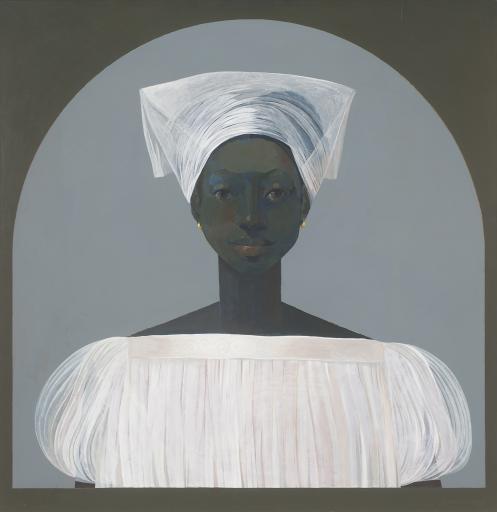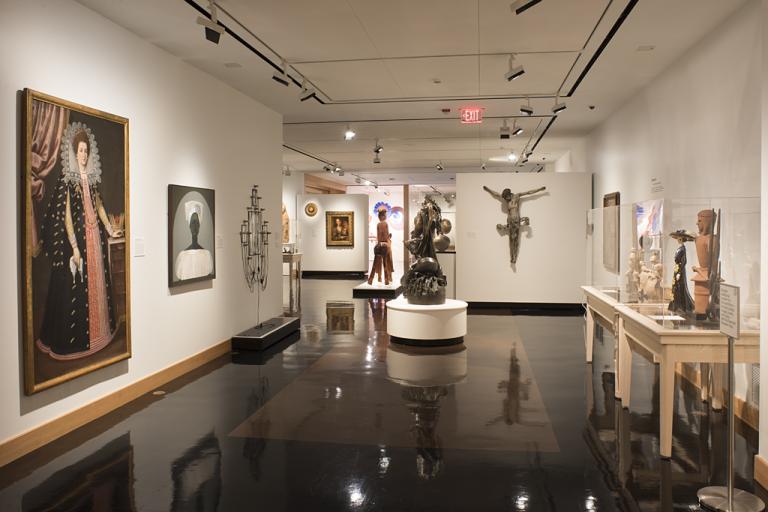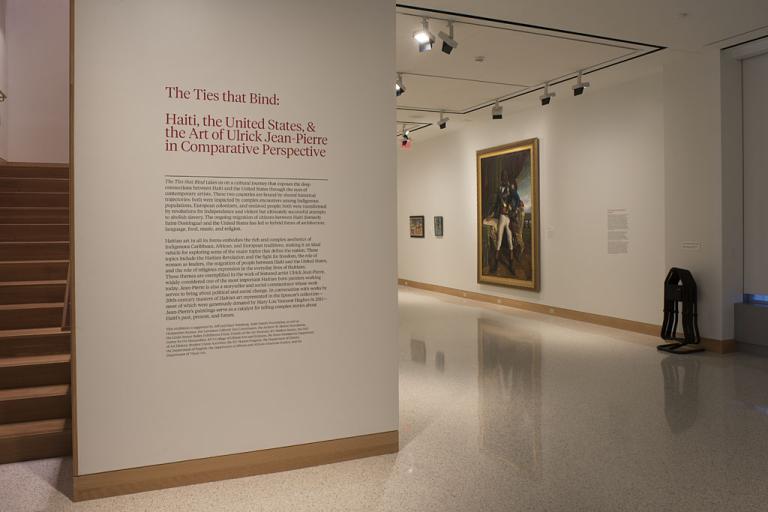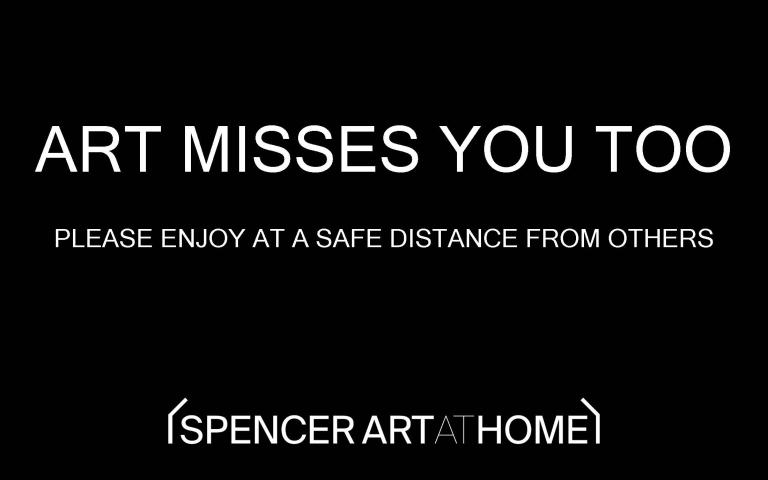Asefi (enough daughters), Bernard Séjourné
Artwork Overview
Canvas/Support (Height x Width x Depth): 104 x 101 cm
Canvas/Support (Height x Width x Depth): 40 15/16 x 39 3/4 in
Frame Dimensions (Height x Width x Depth): 41 x 40 1/4 x 1 1/4 in
If you wish to reproduce this image, please submit an image request
Images
Label texts
Subtly hinting at the connection between Haitian people and the transatlantic slave trade, the elongated neck and facial features of this young Haitian woman are reminiscent of Senegalese women in West Africa. Dressed in white and framed by an arched opening, this figure may represent an impending spiritual journey. In Christianity, white can reference baptism and marriage. Likewise, in the Vodou religion worshippers and initiates wear white during ceremonies to demonstrate peace, humility, and purity.
Subtly hinting at the connection between Haitian people and the transatlantic slave trade, the elongated neck and facial features of this young Haitian woman are reminiscent of Senegalese women in West Africa. Dressed in white and framed by an arched opening, this figure may represent an impending spiritual journey. In Christianity, white can reference baptism and marriage. Likewise, in the Vodou religion worshippers and initiates wear white during ceremonies to demonstrate peace, humility, and purity.
The elongated neck and facial features of this young Haitian woman are reminiscent of Senegalese women in West Africa, subtly hinting at the connection between Haitian people and the transatlantic slave trade. Her name, Asefi, means “enough daughters” in Haitian Creole. Perhaps she is the last of many daughters in the family, or maybe her name symbolizes the
disappointment her family feels after the birth of yet another girl. The arched opening, eloquent geometry, and symmetrical representation of this portrait convey an aesthetic often found in religious works, a connection possibly befitting the young woman portrayed. Her white blouse and headscarf may represent an impending spiritual journey. In Christianity, white is often associated with baptism and marriage; likewise, in the Vodou religion, worshippers and initiates wear white during ceremonies to demonstrate modesty and purity.
The elongated neck and facial features of this young Haitian woman are reminiscent of Senegalese women in West Africa, subtly hinting at the connection between Haitian people and
the transatlantic slave trade. Her name, Asefi, means “enough daughters” in Haitian Creole. Perhaps she is the last of many daughters in the family, or maybe her name symbolizes the
disappointment her family feels after the birth of yet another girl. The arched opening, eloquent geometry, and symmetrical representation of this portrait convey an aesthetic often found
in religious works, a connection possibly befitting the young woman portrayed. Her white blouse and headscarf may represent an impending spiritual journey. In Christianity, white is often associated with baptism and marriage; likewise, in the Vodou
religion, worshippers and initiates wear white during ceremonies to demonstrate modesty and purity.
The arched opening, eloquent geometry, and symmetrical representation of this portrait convey an aesthetic often found in religious works, a connection possibly befitting the young woman portrayed. Her elongated neck and facial features are reminiscent of Senegalese women in West Africa. Her name, Asefi, means “enough daughters” in Haitian Creole. Perhaps she is the last of many daughters in the family, or maybe her name symbolizes the disappointment her family feels after the birth of yet another girl. Her white blouse and head scarf may represent an impending spiritual journey, whether social (for instance, marriage) or religious. In Christianity, white is often associated with baptism; likewise, in the Vodou religion, worshippers and initiates wear white during ceremonies to demonstrate modesty and purity.
The arched opening, eloquent geometry, and symmetrical representation of this portrait convey an aesthetic often found in religious works, a connection possibly befitting the young woman portrayed. Her elongated neck and facial features are reminiscent of Senegalese women in West Africa. Her name, Asefi, means “enough daughters” in Haitian Creole. Perhaps she is the last of many daughters in the family, or maybe her name symbolizes the disappointment her family feels after the birth of yet another girl. Her white blouse and head scarf may represent an impending spiritual journey, whether social (for instance, marriage) or religious. In Christianity, white is often associated with baptism; likewise, in the Vodou religion, worshippers and initiates wear white during ceremonies to demonstrate modesty and purity.
Exhibitions
Kate Meyer, curator
Celka Straughn, curator
Kate Meyer, curator
Celka Straughn, curator
Celka Straughn, curator
Kristina Walker, curator
Angela Watts, curator
Celka Straughn, curator
Kristina Walker, curator
Angela Watts, curator













